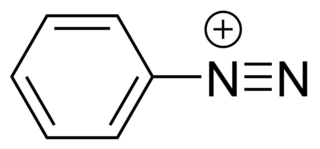
A pigment is a powder used to add color or change visual appearance. Pigments are completely or nearly insoluble and chemically unreactive in water or another medium; in contrast, dyes are colored substances which are soluble or go into solution at some stage in their use. Dyes are often organic compounds whereas pigments are often inorganic. Pigments of prehistoric and historic value include ochre, charcoal, and lapis lazuli.

Hydrazones are a class of organic compounds with the structure R1R2C=N−NH2. They are related to ketones and aldehydes by the replacement of the oxygen =O with the =N−NH2 functional group. They are formed usually by the action of hydrazine on ketones or aldehydes.

Azobenzene is a photoswitchable chemical compound composed of two phenyl rings linked by a N=N double bond. It is the simplest example of an aryl azo compound. The term 'azobenzene' or simply 'azo' is often used to refer to a wide class of similar compounds. These azo compounds are considered as derivatives of diazene (diimide), and are sometimes referred to as 'diazenes'. The diazenes absorb light strongly and are common dyes. Different classes of azo dyes exist, most notably the ones substituted with heteroaryl rings.

Azo compounds are organic compounds bearing the functional group diazenyl.

Sudan I is an organic compound typically classified as an azo dye. It is an orange-red solid, used to color waxes, oils, petrol, solvents, and polishes. Historically, Sudan I used to serve as a food coloring agent, notably for curry powder and chili powder. However, along with its derivatives Sudan III and Sudan IV, the compound has been banned in many countries due to its classification as a category 3 carcinogenic hazard by the International Agency for Research on Cancer. Nevertheless, Sudan I remains valuable as a coloring reagent for non-food-related uses, such as in the formulation of orange-colored smoke.

Azo dyes are organic compounds bearing the functional group R−N=N−R′, in which R and R′ are usually aryl and substituted aryl groups. They are a commercially important family of azo compounds, i.e. compounds containing the C−N=N−C linkage. Azo dyes are synthetic dyes and do not occur naturally. Most azo dyes contain only one azo group but there are some that contain two or three azo groups, called "diazo dyes" and "triazo dyes" respectively. Azo dyes comprise 60–70% of all dyes used in food and textile industries. Azo dyes are widely used to treat textiles, leather articles, and some foods. Chemically related derivatives of azo dyes include azo pigments, which are insoluble in water and other solvents.

Diazonium compounds or diazonium salts are a group of organic compounds sharing a common functional group [R−N+≡N]X− where R can be any organic group, such as an alkyl or an aryl, and X is an inorganic or organic anion, such as a halide. The parent compound where R is hydrogen, is diazenylium.
In organic chemistry, an azo coupling is an reaction between a diazonium compound and another aromatic compound that produces an azo compound. In this electrophilic aromatic substitution reaction, the aryldiazonium cation is the electrophile, and the activated carbon, serves as a nucleophile. Classical coupling agents are phenols and naphthols. Usually the diazonium reagent attacks at the para position of the coupling agent. When the para position is occupied, coupling occurs at a ortho position, albeit at a slower rate.
Arylide yellow, also known as Hansa yellow and monoazo yellow, is a family of organic compounds used as pigments. They are primarily used as industrial colorants including plastics, building paints and inks. They are also used in artistic oil paints, acrylics and watercolors. These pigments are usually semi-transparent and range from orange-yellow to yellow-greens. Related organic pigments are the diarylide pigments. Overall, these pigments have partially displaced the toxic cadmium yellow in the marketplace. Painters such as Alexander Calder and Jackson Pollock are known to have employed arylide yellow in their artworks.

Diketene is an organic compound with the molecular formula C4H4O2, and which is sometimes written as (CH2CO)2. It is formed by dimerization of ketene, H2C=C=O. Diketene is a member of the oxetane family. It is used as a reagent in organic chemistry. It is a colorless liquid.
Diarylide pigments are organic compounds that are used as pigments in inks and related materials. They often are yellow or yellow-green. To some extent, these organic compounds have displaced cadmium sulfide from the market. Being pigments, these compounds exist as (yellow) powders of low solubility in water. They are similar to the simpler monoazo pigments called arylide yellows.

Pigment Yellow 16 is an organic compound that is classified as a diarylide pigment.

Acetoacetanilide is an organic compound with the formula CH3C(O)CH2C(O)NHC6H5. It is the acetoacetamide derivative of aniline. It is a white solid that is poorly soluble in water. This chemical and many related compounds (prepared from various aniline derivatives) are used in the production of organic pigments called arylide yellows, one example being Pigment Yellow 74.
Pigment Yellow 12 is an organic compound and an azo compound. It is a widely used yellow pigment. It is also classified as a diarylide pigment, being derived from 3,3'-dichlorobenzidine. It is closely related to Pigment Yellow 13, wherein the two phenyl groups are replaced by 2,4-xylyl. According to X-ray crystallography, the molecule is nearly planar and exists as the keto-hydrazide tautomer.
Pigment Yellow 13 is an organic compound and an azo compound. It is a widely used yellow pigment. It is also classified as a diarylide pigment, being derived from 3,3'-dichlorobenzidine. It is closely related to Pigment Yellow 12, wherein the two xylyl groups are replaced by phenyl and to Pigment Yellow 14 where the xylyl groups are replaced by o-tolyl. It is often depicted as an azo (-N=N-) structure, but according to X-ray crystallography closely related compounds exist as the keto-hydrazide tautomers.
Pigment Orange 13 is an organic compound and an azo compound. It is a commercial orange pigment. It is also classified as a diarylide pigment, being derived from 3,3'-dichlorobenzidine. It is closely related to Pigment Orange 34, wherein the two phenyl groups are replaced by p-tolyl groups. Its structure has been confirmed by X-ray crystallography.

Toluidine red is an organic compound with the formula C10H6(OH)(N2C6H3 CH3). A dark red solid, the compound is classified as a azo dye consisting of a 2-naphthol group linked to a 2-nitro-4-methylphenyl substituent. Toluidine red is a traditional pigment, found in oil paints. Although once popular, it suffers as a pigment owing to "insufficient lightfastness and bleeding when incorporated into a paint system."

Pigment Orange 34 is an organic compound and an azo compound. It is a commercial orange pigment, i.e. an insoluble colorant. It is also classified as a diarylide pigment, being derived from 3,3'-dichlorobenzidine. It is closely related to Pigment Orange 13, wherein the two tolyl groups are replaced by phenyl groups.

Pigment Yellow 74 is an azo dye and classified as an arylide yellow. It is an intensely yellow-green solid. It is prepared by azo coupling of the diazonium derivative of 2-methoxy-4-nitroaniline with 2-methoxyacetoacetanilide. It is a flat molecule, enforced by the hydrogen-bonding via the ketohydrazide group.
Pigment Yellow 97 is widely used as a yellow colorant, and is classified as an arylide yellow. It is distinguished by the presence of a sulfonylaminophenyl group, which renders the material particularly insoluble. It is derived from two fairly complicated precursors. The acetoacetanilide component is made from 2,5-dimethoxy-4-chloroaniline. The azo component is made from a dimethoxyaniline with the sulfonylaminophenyl substituent.he compound is obtained via acetoacetylation of o-tolidine using diketene. The resulting bisacetoacetylated compound is coupled with two equiv of the diazonium salt obtained from 2,4-dichloroaniline. Although it is often depicted as an azo compound, X-ray crystallography shows that the molecule exists as a hydrazone.













